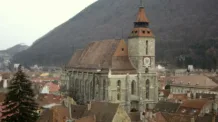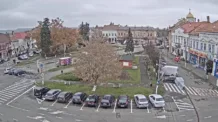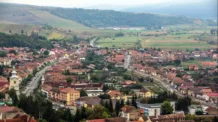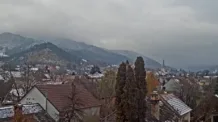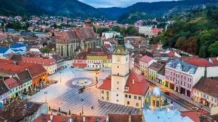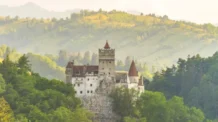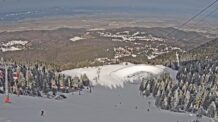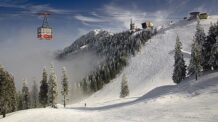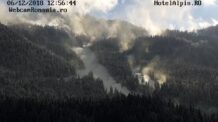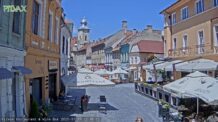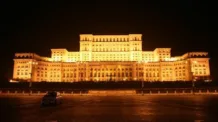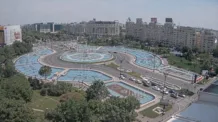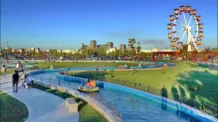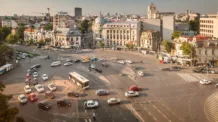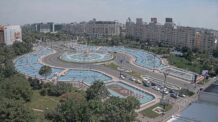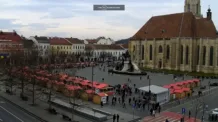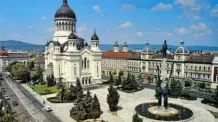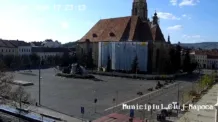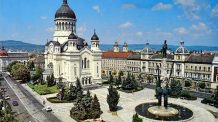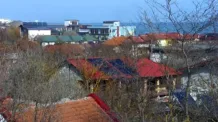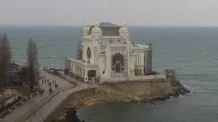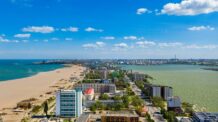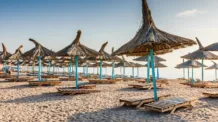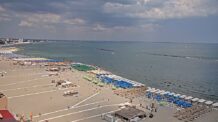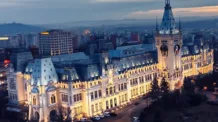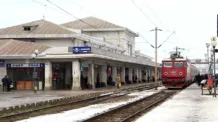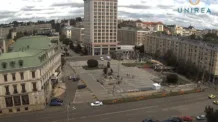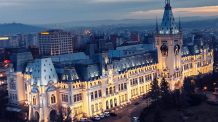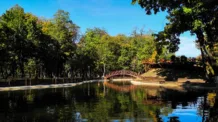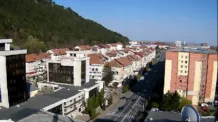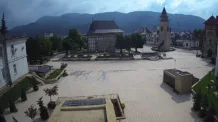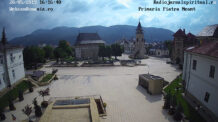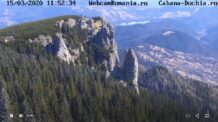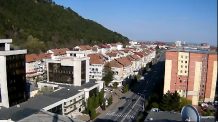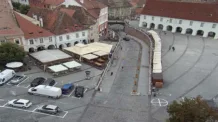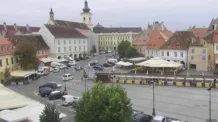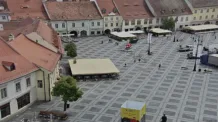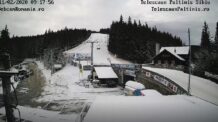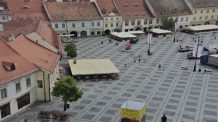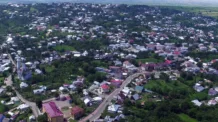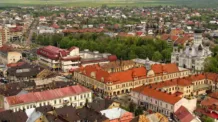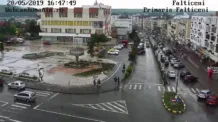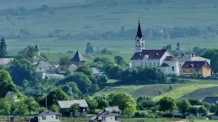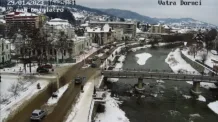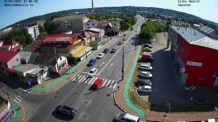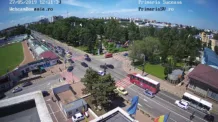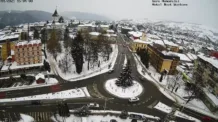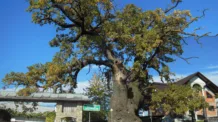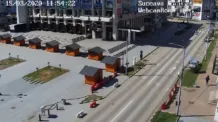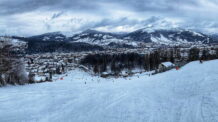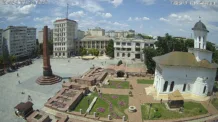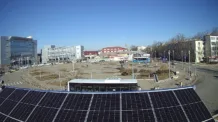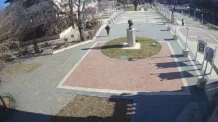Romania is located in southeastern Europe, with Bucharest as its national capital. It was occupied by Soviet forces in 1944 and subsequently became a satellite of the Union of Soviet Socialist Republics (U.S.S.R.) for roughly four decades, under the rule of Nicolae Ceaușescu’s communist regime until 1989. After free elections were held in 1990, Romania joined NATO in 2004 and the European Union (EU) three years later.
The Romanian Republic
Roughly one-third of Romania’s landscape is composed of mountains, another third of forests. Hills and plains make up the rest. The temperate climate is characterized by four distinctive seasons. The country also has a wealth of natural resources, such as fertile land for farming, pasture for livestock, forests with a variety of hardwoods and softwoods, oil reserves, metals like gold and silver in the Apuseni Mountains, numerous rivers supplying hydroelectricity and a Black Sea coast with ports and resorts.
Romanian identity has been shaped by centuries of cultural contact and continuous evolution, due to the country’s location along major continental migratory routes. Romance languages and Eastern Orthodoxy are both products of the blending of Roman settlers and Dacians which occurred throughout history. This is what generally defines Romania’s ethnic and cultural identity today.
The Huns arrived in the 5th century, but Romania and its people virtually vanished from written history until the 14th, when Walachia and Moldavia emerged. In between, folk migrations and conquering cavalryman traversed across the Danubian Plain. Faced with an onslaught of violence, many Romanians chose to take refuge in the Carpathian Mountains. As Helmuth von Moltke observed: “Resistance was futile, leaving flight as their only method of defence.”
The flags of the world against a blue sky. Globalization, global relations, Australia, Canada, the United Kingdom, Poland, Palestine, Japan. Homepage 2010, arts and entertainment, history and society.
Quiz on Britannica
Quiz: Which country has the largest population?
Romanian lands served as a battlefield for conflicting ambitions of neighbours for the next 600 years. During the Byzantine era, the Romanians were unable to resist imperial pressure from the Byzantine empire, then from the Ottoman Turks in Constantinople (now Istanbul), or later from the Habsburg empire and from Russia.
The principalities of Walachia and Moldavia were united in 1859, and in 1877 they declared their independence from the Ottoman Empire as modern Romania. As a consequence, the Cyrillic alphabet was converted to Latin and students left to study in western Europe, especially France, for higher education.
Access exclusive content with a Britannica Premium subscription.
In spite of its late start as a European nation-state, Romania produced several world-renowned intellectuals in the 20th century, including composer Georges Enesco, playwright Eugène Ionesco, philosopher Emil Cioran, religion historian Mircea Eliade, and Nobel laureate George E. Palade. In her interview with the journalist Rosa Goldschmidt Waldeck (Countess Waldeck) on the eve of World War II, she said:
Rumanians have developed a remarkable sense of temporary and transitory quality over the past two thousand years as a result of severe foreign masters, barbarian invasions, rapacious conquerors, wicked princes, cholera, and earthquakes. A lifetime of survival has taught them that every fall may result in unexpected opportunities and that they always get up and keep going.
Romanian land
Bordered by Ukraine in the north, Moldova to the northeast, the Black Sea to the southeast, Bulgaria to the south, Serbia to the southwest, and Hungary to the west, Romania has a certain symmetry reflected in its physical structure. It is centred on the Transylvanian Basin with peaks of the Carpathian Mountains and their associated subranges and structural platforms forming crescents around it. The plains of southern and eastern Romania are enriched by Danube River and its tributaries creating a fertile outer crescent that encircles up to its frontiers. The land’s topography, geology, climate, hydrology, flora, and fauna have been shaped over millennia by its people as well as its natural environment.
Romania is made up of a range of geographic zones, some of which correspond to the names of their historic counterparts. To the south lies Walachia, stretching from the Southern Carpathians (Transylvanian Alps) to the Bulgarian border and divided by the Olt River. In the southeast rests Dobruja, situated between the lower Danube and Black Sea and covering part of Bulgaria as well. Moldavia occupies only a small area of its previous principality but spreads from the Eastern Carpathian Mountains to Ukraine’s Prut River. Banat covers western Romania, bordered by the Mureș River on one side and Hungary and Serbia on the other. Alternatively, Transylvania is surrounded by various mountains – East Carpathians, South Carpathians and Bihor Mountains – as well as encompassing Banat; it closely follows its former principality’s borders.
Relieved
Romania is dominated by the Carpathian Mountains, which can be divided into three separate ranges: the Eastern Carpathians, the Southern Carpathians, and the Western Carpathians. The eastern side of these vast mountains include the Rodna Mountains and Pietrosu peak, reaching 7,556 feet (2,303 metres). Within this mountain range lies a core of hard rocks with rugged relief. Rivers here have cut narrow gorges – known as cheile – such as the Bistriței and Bicazului gorges – providing wonderful scenery. On its western flank are volcanic ranges Oaș and Harghita with an abundance of volcanic necks and cones, some even preserving their craters. St. Ana Lake – a crater lake located in Romania – is also found here while minerals such as copper, lead, and zinc are yielded from the region’s rich mineral resources. Further along lies a zone of flysch more prone to weathering allowing for striking scenery too. To add to this diverse relief are depressions like Maramureș, Giurgiu, Ciuc, and Bârsei which further break up this mountainous landform.
The Southern Carpathians, or the Transylvanian Alps, lie between the Prahova River valley to the east and the Timiș and Cerna river valleys to the west. The majority of these mountains are made up of hard crystalline and volcanic rocks, a characteristic that has caused them to stand apart from other segments of the Carpathians. Romania’s highest points can be found on Mounts Moldoveanu (8,346 feet [2,544 metres]) and Negoiu (8,317 feet [2,535 metres]), which are both located in the Făgăraș Mountains. Along with Massifs Bucegi, Parâng and Retezat-Godeanu Mountains this massif consists of Romania’s first established National Park – Retezat National Park – which is around 94 000 acres (38 000 hectares), offers magnificent mountain scenery and provides safe refuge for chamois and other animals. Ancient erosion platforms have been present here since Europe’s ancient times and have served as pastures throughout centuries. Communication through Bran, Novaci-Șugag and Vâlcan passes is possible although the picturesque valleys of Olt, Jiu and Dan
The Western Carpathians stretch out for some 350 kilometres between the Danube and Someș rivers. Unlike its other divisions, it is not an uninterrupted range, but rather a collection of massifs alongside a north-south axis. The massifs are divided by deep structural valleys, which were historically good defensive positions – aptly reflected in their names: the Iron Gate of Transylvania (at Bistra), Poarta Orientală (at Timiș-Cerna), and, most famously, the Iron Gate on the Danube.
The Western Carpathians, from the Banat and Poiana Ruscăi Mountains to the Apuseni Mountains, are known for their mineral-rich terrain and large metallurgical complexes at Reșița and Hunedoara. The Bihor Massif is the focal point of the Apuseni Mountains and its fingerlike lower reliefs stand out. Meanwhile, the Cetățile Ponorului area features a unique karst landscape resulting from water erosion along rock joints. Further west are two other mountain ranges: Zărand, Codru-Moma and Pădurea Craiului; while on the south side of Mureș River are two mountains – Metaliferi and Trascău – which are rich in ores with remains of ancient Roman mine works still preserved. Human settlements can be found even in the highest areas of this mountain range as it is less wooded than some other parts.
The Carpathians are accompanied by a rolling terrain known as the Subcarpathians, extending from the Moldova River in the north to the Motru River in the southwest. This area is between 2 and 19 miles (3 to 31 km) wide and totals elevations ranging from 1,300 to 3,300 feet (400 and 1,000 metres). Its topography and mild climate support vegetation including Mediterranean elements like chestnuts, while also boosting agriculture; this region specializes in cereals and fruits, with renowned wines such as those at Odobești or in the Călugărească Valley. Unfortunately, it’s densely populated so economic growth is limited for remote areas with little land for farming.
Tablelands are an important component of Romania’s physical geography. The most significant tableland is the Transylvanian Basin which averages an elevation of 1,150 ft (350 m). Located to the east of the Subcarpathians and Prut River is the Moldavian Plateau, which averages at 1,600 to 2,000 ft (500-600 m). The Dobruja (Dobrodgea) tableland in the southeast has an average elevation of 820 ft (250 m), peaking at 1,532 ft (467 m) in the Pricopan Hills.
Approximately a third of Romania consists of plains, with the greatest extent in the south and west. Since the beginning of the 19th century their economic importance has been continuously increasing. The Walachian Plain, located in the southern region of Romania, can be separated into two sections: the Romanian Plain to the east of the Olt River and the Oltenian Plateau on its western side. The entire region is covered by loess deposits that have produced fertile chernozem soils, which are suitable for farming. The Danube floodplain also has large economic importance due to its abundance of fish and its status as an important commercial route. Its riverbanks have been diked and drained to boost food production while willows and poplars line its shores. Drobeta–Turnu Severin, Turnu Măgurele, Giurgiu, Brăila, Galați, and Tulcea are some of many port towns along this stretch of river that provide additional settlements for rural areas.
The Danube Delta is an ecologically unique and significant region. Lying on the northern edge of Dobruja, and abutting the Moldavian Plateau, it covers a vast 2,000 square miles (5,180 square km), the majority of which lies within Romania. It was originally a large bay, but overtime became separated from the sea by sandbanks. In 1991 it was recognised as a UNESCO World Heritage Site due to its abundant biodiversity; many species of birds can be found there, along with illicitly harvested sturgeon and herring providing Romania with half its fish production. It is a popular tourist destination as well as a focus for scientific research and conservation projects alike. Over two dozen settlements are scattered across the delta though many of them are susceptible to flooding from time to time. The major ports are Sulina and Tulcea.
At the junction of three tectonic plates, Romania lies in an earthquake zone. Devastating earthquakes in both 1940 and 1977 caused considerable damage and fatalities.
Romanian drainage
The vast majority of Romanian rivers are tributary to the Danube, which forms its southern border from Moldova Nouă to Călărași. Of the total water that ends up in the Black Sea, nearly two-fifths is provided by such rivers. Most prominent amongst them are the Prut, Mureș, Olt, Siret, Ialomiƫa and Someș. The Danube empties into three arms – the Chilia (two-thirds), Sfântu Gheorghe (one-fourth) and Sulina (the remaining amount). The striking delta region is a sight to behold. While these rivers possess great hydroelectric potential, their flow is not easy to control as there aren’t many natural lakes regulating it. Their combined surface water capacity is minuscule compared to that at the mouth of Danube which is over five times greater than it. Additionally, Romania has an estimated 250 billion cubic feet of subsoil waters yearly.
Despite its tremendous hydroelectric potential, only a fraction of Romania’s theoretical capability can be used due to technical and economic restrictions. The highest concentration of reserves are located along the Danube river and in mountain valleys across the country. Other water sources include upwards of 2500 lakes, varying both in size and environment from glacial ranges to lowland areas and marshes in the Danube delta region. Since the 1940s, efforts have been mainly focused on harnessing power from the Argeș, Bistrița, Lotru, Olt, Mare, Sebeș, Someș rivers as well as along the Danube at Iron Gate.
The soil
Romania is well-endowed with fertile lands. Roughly one-fifth of its territory consists of chernozem – soils high in humus content and black in color. Reddish brown forest soils are located on the plains to the east and south of Carpathians and in Banat, whereas gray-brown podzolic soils are found at higher altitudes. Lastly, vast areas of alluvial soils can be seen in the Danube floodplain. Unfortunately, during the communist era, peasantry resorted to unsuitable farming techniques and after 1990, large amounts of pesticides and industrial waste had been recklessly discharged, leading to a legacy of soil erosion.
The climate
Romania’s geographical position in Southeastern Europe means it has a climate which sits between the milder temperate climates and the more extreme weather of the continent’s interior. In the west and centre, there are humid Atlantic traits, in the southeast effects of the Russian Plain (East European Plain) are detectable. Sub-Mediterranean influences even can be felt in the corner of Romania furthest from northern Europe. Nevertheless, topography plays a role too and different climates can be found at various altitudes.
Ocean: The World of Water, two globes showing the eastern and western hemispheres
Quiz on Britannica
It’s up to you!
The average annual temperature is in the low 50s F (about 11 °C) in the south and in the 40s F (about 8 °C) in the north, although, as noted, elevation and other factors greatly influence the temperature. A typical extreme temperature in the Brașov Depression is –37 °F (–38 °C), ranging from 112 °F (45 °C) in the Bărăgan region.
The average annual rainfall for Romania is about 25 inches (640 mm). This number rises in the Carpathians with an annual precipitation of 55 inches (1,400 mm) and drops to just 16 inches (400 mm) in the Dobruja area. Unfortunately, this has led to a pattern of both droughts and floods in certain regions. For example, since the 1990s Romania’s north has been subject to heavy rainfall and flooding while its south has dealt with drought and high temperatures. These issues have been compounded by poor agricultural practices which materialized after 1998 and 1999 when particularly intense precipitation resulted in landslides, destruction and casualties in the Retezat Mountains.
Northwest winds are usually the strongest, but drier winds from the northeast are often the strongest. Western Romania is characterized by a hot southwesterly wind, the austru. The eastern part of the country is surrounded by cold and dense air masses in winter. The cold northeasterly known as the crivăț blows in from the Russian Plain, while the oceanic air masses from the Azores in the west bring rain and reduce the severity of the cold.
As a result, Romania has four distinct seasons, though the transition from winter to summer is rapid. Autumn tends to be longer in Romania, with dry and warm weather from September to late November.
Animals and plants
Covering one-fourth of Romania’s land, forests are an integral element in the vegetation makeup, particularly in the mountains. Oaks occupy areas up to 800 metres, beeches lie between 800 and 1,400 metres, whilst conifers spread from 1,400 to 1,800 metres. The highest altitudes contain Alpine and sub-Alpine pastures. Unfortunately, centuries of human settlement and agriculture have greatly diminished natural vegetation in the tableland and plains regions.
The Carpathian Mountains house a diverse array of wildlife, featuring rare species such as chamois and eagles. Brown bears, red deer, wolves, foxes, wild pigs and lynxes all roam the forests, while martens and various songbirds make their home in the same area. The Danube River’s lower stretch is particularly rich in both animal and fish life. The delta of the river serves as an important sanctuary for numerous bird species like pelicans, swans, wild geese, ibis and flamingos which are all legally protected along with wild pigs and lynxes. Furthermore, this habitat is used as a seasonal roosting spot by migratory birds. Several uncommon feathered inhabitants are present in the delta and neighbouring Dobruja region – Dalmatian pelicans, pygmy cormorants, spoonbills, red-breasted geese and white-fronted geese have been spotted alongside whooper swans.
There is a wealth of historical and archaeological pieces of evidence that suggest the present-day Romania was home to a well-developed society of Dacian people long before the Roman conquest of the area, which became the province of Dacia. This sizeable Roman influence had an enduring impact, creating a civilization that managed to keep up with its distinct character during the migration waves following the downfall of the Roman Empire. As such, it’s no wonder then why some Romanian people trace their country’s roots back to this mixture between native Dacians and Roman settlers.
Nearly all of Romania’s citizens are ethnically Romanian, while Hungarians largely reside in the northwest of the country in Transylvania. A few individuals identify themselves as Roma (Gypsies), although ethnic Germans are even fewer in number. In 1930 there were an estimated 342,000 German nationals living in Romania, which constituted roughly 4% of its population at the time. Following World War II, many ethnic Germans were deported to the Soviet Union, with others taking advantage of opportunities to immigrate to West Germany. After 1989’s Romanian revolution, an additional mass exodus of ethnic Germans to Germany occurred. By the early 21st century, only a tiny portion of Romanians were German.
In the same vein, the Jewish population of Romania decreased significantly during and after World War II. As a result of the Holocaust and emigration opportunities, the Jewish population declined from 750,000 in 1930 to 43,000 in 1966. In the aftermath of the revolution, a mass exodus to Israel resulted, leaving a smaller Jewish community behind.
The languages
Romanian is the official language of the country, although technically it is the Daco-Romanian dialect spoken by nine-tenths of the population in several regional variants. Only Hungarian is spoken by more than a million people in Romania. Other languages spoken by fewer people include Romany, German, Turkish, Serbian, and others.
Theology
Religion in Romania
Under communist rule, religion was viewed as a personal matter and few restrictions were imposed (as compared to other communist regimes). Although the state sought to promote science and empiricism over religious teachings and faith, they maintained administrative and financial control of churches through registering them with the Department of Cults. Despite government interference, Romanians remained committed to their faith. After 1989’s revolution, freedom of religion was restored.
St. Michael’s Church, Cluj-Napoca, Romania
Nearly 90% of Romanians are followers of the Romanian Orthodox Church, with a patriarch located in Bucharest. Catholic faiths are mainly adhered to by ethnic Hungarians and Swabian Germans. Transylvania is especially known for its Eastern Rite (Uniate) church, which had its independence taken away from it during communist rule in 1948, but was rescued after 1989. Both Lutheranism and Calvinism are practiced among some Hungarians and Germans, while other Protoastant sects found in Romania include Presbyterian Evangelicalism and Unitarianism. During the 1950s, Baptists, Seventh-day Adventists and Pentecostals were made to form the Federation of Protestant Cults, but they saw their freedom restored after 1989 as well. As for other religions found in Romania, there is a small Jewish population scattered around the country, with Islam being followed predominantly by ethnic Tatars or Turks – particularly in Dobruja or along the coasts of the Black Sea. The Roma have always intertwined Romanian Orthodoxy with their own spiritual customs; since 1989 some have been drawn to Pentecostal and Evangelical strands of Protestantism
Patterns of settlement
Urban-rural Romania
Romania’s natural environment has long facilitated human settlement. Due to its accessibility to the movement of people across the Eurasian landmass, Romania has been predisposed to absorb cultural influences from many countries and peoples, and this is also reflected in its contemporary patterns.
About one-third of Romania’s population lives within Transylvania and Dobruja, with the other two-thirds residing in Walachia and Moldavia. During the medieval period, these four princedoms were independent states, with mountain ridges defining the political boundaries. The main populations initially occupied hilly areas on the Carpathians; however, through time they relocated to a lower altitude, progressing from Târgoviște and Suceava to Bucharest and Iași. Romania also has an ethnically diverse people: the Roma community is combination of those who identify with Romanian culture and those that maintain a nomadic lifestyle, while Ottoman rule left behind ethnicities such as Turks and Tatars along the Danube River.
The Szeklers, a Hungarian-speaking people, populated Transylvania in the 900s. Around the same time, the Hungarians invited Saxon Germans from Rhineland areas to settle along the Carpathian arc for defense against Tatars and Turks; this led to many fortified villages and religious sites being built (and later designated UNESCO World Heritage Sites in 1993). In the 14th century, migrations of Roma began arriving to Romania from Northern India and were enslaved until mid 19th century. As part of Austria-Hungary’s Habsburg rule, they encouraged Germans to settle in Banat during 18th century. Luring them with land grants, livestock provisioning and tax exemption was meant to help strengthen fortification as well as spread Catholicism across Eastern Europe. The majority of Germanic settlers came from Swabia, though they were all known as ‘Swabians’ by Hungarians. Eventually, Serbs, Croats, Bulgarians and Romanians also moved into the plains of Banat before Jews from Poland and Russia migrated there in early 19th century.
Romanian urban settlements were located at places of commercial or military significance, and most modern towns are either on or close to the ruins of their predecessors. The oldest towns were founded on the Black Sea coast and urbanization then spread to plains and mountains. There is evidence that the main trans-Carpathian routes provided a path for the development of settlements at both ends into modern cities. This growth has been aided by Romania’s volatile history, as well as its ancient trading networks. The mountains served concurrently as a shield and link in the country’s development. During the Middle Ages, many Ungureni (Romanians from the inner side of Carpathians under Hungarian rule) moved over to settle on the outer side due its outstandingly suitable farming land. Places with long-term occupancy can be seen amongst these mountain ranges, including very old place-names and regional unity.
A dispersed type of rural settlement is generally found in the foothill, tableland, and upland regions. The scattered village proper inhabiting those heights has retained many traditional features in architecture, clothing, and social customs and preserves their importance of the old market centres or nedei. Dwellings are carved out wherever possible amidst forests and pastures, while further down the slopes where the terrain is less challenging they may be slightly closer together – although still individualised to fit between agricultural plots. Mining, animal breeding and farming represent the mainstays of economic activity in these villages; agriculture on terraced mountainsides being a leftover from Roman times. This settlement style is particularly discernible in the Subcarpathian region, with its hills and valleys covered by ploughed fields, vineyards, orchards and pastures dotted with dwellings. In contrast to this more familiar pattern can be found those settlements concentrated in plain areas dedicated to cereal production.
An old cobbled alley in Sibiu, Romania
A collection of towns encircle the Subcarpathian region, with many of them mirroring those found dominating the major trans-Carpathian passes. Examples of these “double towns” are Suceava and Bistrița, Făgăraș and Câmpulung, Sibiu and Râmnicu Vâlcea, Alba Iulia and Arad, as well as Cluj Napoca and Oradea. Unlike Transylvania which received substantial urban growth during ancient periods with Dacians and Romans, Moldavia only began to build its cities in Middle Ages. At that time their former capitals like Iași and Suceava maintained good trading relationships with Transylvanian towns for items moving between Black Sea and Baltic ports.
The Romanian capital
Romania’s capital
A majority of Romanians lived in the countryside, while minorities such as Hungarians, Germans, Jews, Greeks, and Armenians lived in the cities. As industrialization began in the 19th century, this pattern began to change, and ethnic Romanians have now become the majority in large cities.
Trends in demographics
Age breakdown in Romania
Romania saw a dramatic shift in its social fabric due to industrialization and urbanization, which caused the working-class population to increase. Similarly, collectivization of agriculture altered the rural population. Since World War II, education has become more accessible – contributing to an upward trend for those receiving higher education. Economic disparity between regions also played a role in increased migration from rural areas to towns and cities. In an effort to minimize this and distribute development evenly throughout Romania, the communist government made attempts to equalize opportunities; however, these efforts have not wholly diminished regional disparities.
Since the turn of the century, population density across the country has more than doubled. Even so, it is still lower than many neighbouring European countries. Nevertheless, this overall figure masks a wide divergence between different regions. Areas occupied by towns generally have the highest densities, with those at low elevation containing intensive agriculture and historically high birth rates (e.g. northern Moldavia) following close behind. Conversely, areas from 700 to 2000 feet rich in mines, fruit farms, vineyards and pasture land often display the lowest figures.
Since the 1990s Romania’s population has decreased considerably. This is believed to be due to a variety of reasons, with the primary one being the removal of communist restrictions on abortions and birth control which caused a rapid fall in the birth rate. Poor standards of living and medical care have also had an impact on life expectancy, as stillbirths and infant mortality – which had dropped from the 1970s to 1980s – rose again in the late ‘80s and stayed high until the early 2000s. In addition, fewer than one-sixth of those under 15 years old remained by 2001, causing alarm about Romania’s population decrease. Furthermore, prior restraints on emigration were lifted which saw people from ethnic minorities such as Germans leaving as well as young Romanians heading West for better economic prospects.
The economy
Since the 19th century, Romania’s economic development has been bolstered by its open maritime trade to western Europe. After winning independence in 1878, the country made efforts to expand production of wheat, timber and oil. Even so, Romania continued to have a largely agrarian economy at the end of World War II. During the communist regime thereafter, industries such as mineral processing, chemical production and engineering were given priority with cheap workforce taken from rural regions. Unfortunately, those living on farms saw their own land confiscated while they received minimal wages as farmworkers. This was partially enabled through close economic ties with the Soviet Union that provided relatively inexpensive resources like fuel and raw materials in exchange for manufactured goods.
Socialist development drastically altered the economy. The share of industry’s contribution to national income skyrocketed from 35.2% to 68.3% between 1938 and 1986, while unemployment was managed despite a surge in population numbers, allowing services to develop and meet demand. Transportation networks were modernized, enabling more families to enjoy vacations on the Black Sea coast or visit mountain resorts. However, even with these advancements, incomes stayed low and living conditions remained subpar (with high-density housing and meagre welfare standards). Industrial production was often inefficient – factories being overstaffed led to low productivity and goods of suboptimal quality that could only be sold within the communist bloc or at below-cost prices on world markets. Securing vast development loans from Western creditors in the 60’s and 70’s reduced reliance on foreign capital, which were all paid off during the 80’s. Consequently, many industrial sectors fell short of investment into new technology, whilst a primitive command structure limited people’s ability to innovate or take initiative. Chemical industries saw particularly adverse effects with severe pollution issues emerging as a result.
The postcommunist government had a difficult time transitioning to a market economy. It took a cautious approach with privatization, as many Romanians lacked significant capital and foreign investors were hesitant to invest in state-owned enterprises. Despite hoping the reestablishment of markets previously lost to the Soviet Union dissolution would reinvigorate production and restructuring would occur gradually, shifting to a market economy went at an intermittent slow pace throughout the 1990s. This left the government having to support numerous unemployed workers while being saddled with an outdated industrial base. In spite of this, there was growth in small retail and tourism-related businesses.
As of the end of the 1990s, Romania had developed a mixed economy and was clearly moving toward a market economy. However, heavy industry, mining, transport, and communications remained under government control and were relatively immune to market forces. As a result of high unemployment and inflation rates, living standards declined overall.
In 1989, following the revolution, there was an initial surge of foreign aid. However, due to complicated and variable investment and taxation laws as well as the idea that corruption was widespread, further investment and aid were discouraged. After amendments to the legislation in 1997 to encourage international capital, Romania established the Romanian Agency for Foreign Investment in 2001. In the early 2000s there were prominent contributions from the Netherlands, Austria, France, Germany, Italy and the United States. During this period the gross domestic product (GDP) soared; in just six years (2002-2008) it had more than quadrupled and single digit inflation began at around 2005.
Private property rights and a market economy are guaranteed by the constitution. Natural resources are public property, but they can be leased. Thousands of state-owned enterprises (apart from utilities) have been privatized.
Fishing, forestry, and agriculture
Agriculture has been a pillar of the Romanian economy; more than one-third of the country’s land is devoted to farming, including vineyards, orchards and vegetable patches. In 1921, a land reform movement was launched, culminating in 1948 with farmland being redistributed from large owners to peasant farmers. After the communist takeover in 1949, compulsory collectivization was enforced until 1962. Since 1989, state farms have been left alone but collective farms split into individual holdings; although certain areas have seen this arrangement replaced with cooperative associations. Romania has encountered major difficulties following the dismantling of these collective farms and the accompanying lack of ownership assurance. The small individual plots resulting from this shift have typically been used to cultivate subsistence crops long-associated with peasants. Despite 1995 bringing a bountiful cereal harvest, agriculture went on a downward trajectory in the 1990s due to inadequate capital investment and limited technological solutions. To make matters worse, irrigation systems installed during the communist era – especially on the southern and western plains – had fallen into disrepair by 2000. Since 2003 aid from the World Bank has allowed for restoration efforts to take place. In the early 21st century around one-fourth of the labour force worked in agriculture and associated industries; yet they only contributed less
The extensive Romanian plains are ideal for the cultivation of cereal crops, which can also be found in the Subcarpathians and Transylvanian Basin, representing a large portion of arable land. Wheat and corn are the most significant cereals grown, with barley, rye and oats following. Two-row barley is cultivated in Brașov, Cluj and Mureș areas primarily for beer production. Yet, yields of cereal crops have been increasing, leading to a decline in acreage as industrialised farms demand more space.
A Romanian farmer hoes potatoes near Cugir, in the foothills of the Transylvanian Alps.
Vegetables, legumes— such as peas, beans and lentils—are predominantly planted in relatively small plots. This allows for an early harvest of the peas and then a second crop of fodder to be grown on the same ground. The city of Bucharest is especially known for its vegetable cultivation; being particularly noted for its early potatoes, tomatoes, onions, cabbages, and green peppers. Similar gardening areas can also be found around other cities such as Timișoara, Arad, Craiova, Galați and Brăila. The Brașov, Sibiu, Harghita and Mureș districts are renowned for their potato production. Other related crops include sugar beets; sunflower seeds commonly seen on the Danube plains; hemp; flax; rape; soybeans; and tobacco.
Romania is an important wine-producing nation in Europe, and its wines have gained recognition among a wider international audience due to the growing popularity of tourism. Its production of high-grade wines, through modern methods, has generated large annual exports across the world. The superior vineyards at Odobești, Panciu and Nicorești are well known; however, there are several other noteworthy producing regions too. Both white and red varieties have been honored with numerous international accolades.
On almost every hillside along the Carpathians’ edge, there are orchards between 1,000 and 1,600 feet (300 and 500 metres). Orchards specialize in fruits with high economic yields. Many unstable hillsides have been solved by orchards to prevent soil erosion.
Raising livestock in Romania goes back to antiquity. Sheep are bred where there is an abundance of grass, from the Alpine pastures to the Danube plain and valley. The cattle population is divided almost equally between beef production, an important export, and other purposes. The livestock industry experienced a downturn during the 90s, but by the start of the new millennium a reversal was seen with a notable rise in beef exports. Dairy products also form an integral part of Romanian agriculture, along with wool, eggs and honey.
Traditionally, Romanian forests produced sawn timber, but since the 1990s, the country’s forests have been focusing on finished products. The timber is used primarily for building materials, fibreboard, and furniture production. The Danube delta produces cellulose, which is used to make hardboard.
Romania is home to a vast selection of waterways, including rivers, lakes and its Black Sea coastal region. During communist rule, Romania heightened ocean fishing to increase the export of meat. Since the 1990s however, fish demand has declined due to fleet and resource reduction alongside an increase in the price of fish relative to other animal protein products. The majority of the annual catch is consumed fresh and primarily comes from the Danube River. In 1986, Romania’s leader Nicolae Ceaușescu tried to convert portions of the Delta into grain fields by forcing local residents out, building dikes and flattening grounds with crops such as wheat and rice. This led to many plants and animals being killed. As a result, in 1991 a Danube Delta Biosphere Reserve was founded by the Romanian government in order to begin restoration efforts. Fish species native to the Delta region consist of carp, sheatfish, pike and zander; additionally species that migrate from the Black Sea are also found – including Danube mackerel and sturgeon which produces caviar–Romania’s most valuable fish product. Nevertheless in 2006 Romania issued a 10-year ban on commercial sturgeon fishing due to worry over decreasing population numbers.
Power and resources
Romania is renowned for its wealth in natural resources. Hydrocarbons can be found across two-thirds of the country, with the petroleum sector having originated in the 19th century. Flysch formations which stretch through the Carpathian and Subcarpathian areas are known for their oil deposits. Videle, Bacău, and Ploiesti have been associated with refinery production since World War II; Pitești began producing it more recently. In 1981, Black Sea deposits also revealed oil. Romania has historically possessed ample quantities of natural gas, mainly located in Transylvania where salt and methane were mined to create a chemical industry during the 1930s; these reserves are now notably diminished.
After the Second World War, Romania faced the significant challenge of a lack of power stations fuelled by anything other than petroleum, following reparation demands from the Soviet Union. However, a plan put in place between 1951 and 1960, with additional developments subsequently taking place, enabled an impressive upturn in power output. This transformation can be attributed to the installation of power plants ranging from 200,000 to 1 million kilowatts in size – both thermal and hydroelectric. Taking advantage of its many rivers plus the Danube, Romania has been able to tap into its considerable hydroelectric potential. Over half of all electricity produced is generated at the Iron Gate and Cernavodă on the lower Danube boasts two nuclear reactors – initiated with Canadian aid – one established in mid 1990s, with another coming online in 2000.
A medieval castle-museum in Hunedoara, west-central Romania, is built on coal.
Bituminous coal (or soft coal) features the largest reserves; half of Romania’s bulk production stems from the Jiu Valley. Lignite, of poorer quality, is being increasingly used to answer energy needs. The majority of these deposits are found along the slopes of mountain ranges, with concentrations in Moldavia and Transylvania nearby Cluj, as well as in the Jiu Valley and on the Danube floodplain. Anthracite (hard coal), on the other hand, is situated in Banat and Walachia regions. Mining plays a particularly important role in Jiu Valley where it is essentially the sole industry and recurrent layoffs have caused protests that sometimes erupted into violent confrontations.
Romania is home to a variety of metals, such as iron, manganese, chrome, nickel, copper, lead, zinc and silver. Gold and molybdenum can be found in the Apuseni Mountains and bauxite in the southeast of Oradea. You can also find smaller amounts of sulphur, graphite, and mica. Lastly, there are ample salt deposits around Slanic, Tirgu Ocna and Ocna Mures.
The manufacturing industry
Following the conclusion of World War II, there was a dramatic transformation in Romanian manufacturing. Metalworking and engineering significantly increased their output from 13.3 percent to 25.8 percent in 1990, with electricity and fuels increasing from 13.2 to 19 percent, and chemicals leaping from 3.1 to 9.6 percent as well. Metallurgy and building materials saw a slight growth too, whereas wood processing, paper, textiles and clothing, plus food processing had minimal relative advancements.
The 1989 revolution in Romania caused a discouraging stagnation of the manufacturing sector that followed into the 1990s. The heavy industry investments by the communist government suffered from insufficient maintenance and modernisation during the economic restraints of the 80’s, rendering them inefficient and uncompetitive. This was heightened by an aggravated workforce due to inflation of salaries for communist officials, accompanied by inexperienced and unprofessional management who were ill-prepared for international business ventures. All these factors resulted in a weakened state of Romanian manufacturing that proved no match for world market competition.
It was the conflict between former managers of heavy industry, opposed to transition to a market economy, and labourers, seeking reform, that shaped political developments in Romania in the years following the revolution. A country’s plans for manufacturing, mining, metallurgy, and energy sectors, and workers’ responses to them, determine whether it rises or falls.
At the start of the 21st century, much heavy industry was underused or running at lower levels than needed. Conversely, light industry presented a positive outlook, tempting some foreign investors to put money into joint-ventures. Machine building and metal processing is still the main component of industrial production in Romania, contributing around one fifth of all industrial output. This is indicative of the changing trend within Romanian economy since before World War II this sector only had a ten percent share; food processing and the textile and clothing sector were more significant at that stage. Key industrial cities include Bucharest, Brașov, Ploiești, Cluj-Napoca, Craiova, Arad and Reșița. A clear movement towards embracing modern branches such as electronics was observed throughout the 1990s when several foreign producers established their operations in Romania attracted by both low labour costs and close proximity to markets in Western Europe.
The iron industry in Romania has close associations with Galați, Călărași, Hunedoara, and Reșița – the latter having a long history dating back to the eighteenth century. In addition, smaller ironworks can be found at Brăila, Câmpia Turzii near Turda, Iași, Oțelul Roșu, Roman and Târgoviște. The non-ferrous metallurgical activity also dates back to Dacian-Roman times and is largely located in the southwest and west of the country. Gold and silver production still take place there today – especially in the Apuseni Mountains. Aluminum production was added more recently with alumina factories in Oradea and Tulcea supplying a reduction complex in Slatina within the Olt district.
Metallurgy relies on external sources of ore and coke, whereas the wood products industry is amply supplied domestically. This chain of modern wood industrialization produces an impressive array of goods, such as furniture and chipboard, which have found success in foreign markets. Building materials are sourced from across the country and cement manufacturing constitutes a key component; the main centres for this are located at Turda, Medgidia, Bicaz, Fieni and Târgu Jiu.
A radical overhaul in the 1930s has also led to steady development for the long-established textile industry. A substantial amount of investment has been made in new plants for the closely related ready-made clothing industry, while silkworm production remains modestly important despite the introduction of synthetic fibres.
The food industry has been largely eclipsed by the rapid development of other sectors, but it has continued to grow in absolute terms, and processing plants are spread throughout the country.
The financial sector
The early excitement that followed the 1989 revolution slowly died down in the 1990s, when foreign investment began to decrease. Romania’s fiscal stability was endangered multiple times by the high levels of inflation throughout this era. To curb this upward trend, the leu was revised in 2005. The National Bank of Romania, founded in 1880, ensures that the Ministry of Finance’s monetary policy is carried out, overseeing money allocated to budgets and printing money. Trading of various companies commenced on Bucharest Stock Exchange in 1995 and had expanded to hundreds by 1999. By 1998 there were several banking institutions present in Romania – both domestic and international ones as well as those jointly owned by them.
Romanian trade
Import sources in Romania
The Romanian economy underwent an important transformation during the communist period, as its foreign trade and commercial relations significantly expanded, reaching a total of over 100 countries. Romania was the first member of Comecon (the Council for Mutual Economic Assistance) to negotiate with the European Economic Community (which became the EU later), managing to do so in 1980 when they signed a trading agreement. The nation also took part in many international fairs and exhibitions. Upon Comecon’s disbandment in 1991, focus shifted to increase trade with both industrialised Western nations and less developed ones. Unfortunately, the decade following this saw a failure by the Romanian leadership to implement the macroeconomic reforms that other eastern European countries had adopted while transitioning. Nevertheless, 1993 brought better news as the US reinstated their Most Favoured Nation Trading Status with Romania; which had been suspended since 1988.
Export destinations in Romania
By the start of the 21st century, Romania’s exports comprised mainly textiles and clothing, making up more than one-fifth of their total exports, followed by metals, electrical equipment, oil and nonelectrical machinery. Main imports included textiles, machinery, electrical equipment, chemical products, food and oil. Foreign trade has grown since the 1990s but exports weren’t increasing as quickly as imports leading to a deficit in balance of payments. In 2007 Romania joined the EU as part of measures to create a free market economy and reduce corruption with smuggling. Unfortunately their efforts to obtain visa-free Schengen privileges were unsuccessful due to other members’ worries about possible abuse. Italy, Germany, Hungary, France and Turkey are Romania’s primary trading partners.
Providers
Approximately 10% of Romania’s workforce is in the service sector. Tourism has considerable potential to bolster Romania’s economy. Unfortunately, due to the unsteady economy, ethnic conflict and rumours of deprivation and shortages, visitation plummeted in the early 1990s. The majority of guests at that time were from surrounding nations such as those in the Balkans and Turkey. Initiatives to improve lodging, particularly in major cities, combined with a favourable exchange rate saw tourism restored; between the late 90s and early 2000s foreign visitors essentially doubled.
Tourist spots in Romania are plentiful and varied, from winter sports in the mountains to summer beach activities on the Black Sea coast. Special attention is given to health spas, notably those developed on Transylvania’s salt lakes in Ocna Sibiului and Sovata. Tourists also come for the historic town of Sighiůoara and some of the newer towns built after WWII such as Năvodari, Mamaia, and Eforie. Lakes Tașaul, Siutghiol, Agigea, Techirghiol, and Mangalia hold significance not only because of their beauty but also because they contain deposits of mud and hot springs believed to have therapeutic properties. Meanwhile experts in ecology and conservation have been drawn to the Danube delta. Other tourist attractions include mountain lakes and underground caves in the Carpathians and old churches and monasteries with elegant 15th-16th century frescoes located in northern Moldavia. Romanian folk costumes, along with ancient folklore from the Carpathian Mountains, complete this reminder of Romania’s long-standing cultural heritage.
Taxation and labor
The collapse of communism resulted in high unemployment, but as more people migrated in the 1990s, certain sectors of the economy, such as construction, agriculture, tourism, mechanical processing, and clothing, experienced labor shortages.
Over two-fifths of Romanians work in retail, education, and health care, and are typically women. Romania has a problem with child labour, especially among Roma girls, with children generally employed in agriculture, construction, and domestic work. Although a number of laws were passed at the beginning of the 21st century to eradicate child labour, the problem persists.
A number of hopeful signs emerged in the 1990s, including the development of strong and independent labour unions and chambers of commerce. Additionally, a union of producers and credit institutions dating from the communist era, the Central Union of Consumer and Credit Cooperatives, is emerging, as are organizations that are appropriate for the private economy.
A wage tax, a corporate tax, and a public finance tax exist in Romania. A value-added tax (VAT), a capital tax, and a global income tax were also implemented in the 1990s to attract foreign investment. A flat income tax was introduced in 2004 for corporations and individuals.
Telecommunications and transportation
Located at a nexus of European transport, Romania is renowned for its railway network. The main lines offer good regional service and include two that traverse the Danube: Cernavodă (connecting Bucharest to Constanța) and Giurgiu (linking Romania to Bulgaria). Since the 1930s, diesel locomotives have been in circulation, while one-third of the major rail routes have undergone electrification. Additionally, many of Romania’s national roads have been modernized.
Romania’s main lines of communication centre on Bucharest and encompass many picturesque routes. The nation also has several maritime connections with multiple other countries, the most important being Constanţa port, which has seen considerable expansion and plays an essential role in the economy. Furthermore, the Danube River – supplemented since 1984 by the Danube-Black Sea Canal from Cernavodă to Constanța – is a key transportation link between western Europe, the Middle East and the Black Sea. On this river are located Drobeta-Turnu Severin, Calafat, Giurgiu, Turnu Mǎgurle, Calarași, Brăila, Cernavodǎ, Tulcea , Galați and Sulina ports. Air travel is mainly channelled through Bucharest; there is ample domestic traffic as well as more international flights becoming more and more significant. There are Guided airports in Constanţa Cluj-Napoca Arad Timisoara Sibiu as well that of TAROM (Transporturile Aeriene Române) Romania’s national airline covering routes to Europe
As a result of privatization in 2003, Romania’s telecommunications market expanded substantially within five years, and Internet access increased significantly. From 2000, when only one-tenth of Romanians subscribed to a cellular service, Romania has significantly more cellular phone subscriptions than people.
Constitutional framework for government and society
Following the dissolution of communism in 1989, the Romanian parliament ratified a constitution on November 21, 1991, which was then accepted by referendum on December 8. This document specified a bicameral legislature composed of a Chamber of Deputies and Senate, with representatives elected to four-year terms from each county based off proportional representation. The number of seats per county is calculated by the number of votes cast within it and allocated among political parties according to their share of the total vote. People elect the president directly; they serve a five-year term and have the ability to impose martial law or national emergencies as commander of Romania’s armed forces and chairman of the Supreme Defense Council. Laws are passed with majority approval in both chambers, though presidential ordinances ordinarily require parliamentary authorization with countersignatures from primary minister (who functions as head of government). Appointed by but not removable from office by the president, this prime minister — together with their cabinet — are responsible for administering domestic and foreign policy.
Government at the local level
The central government appoints a prefect for each county who acts as the local representative of the national government. Citizens directly elect mayors and community council members.
The law
The Romanian judicial system is led by the Supreme Court of Justice, the members of which are appointed by the president to serve six-year terms. It also comprises county courts, local courts – whose decisions can be appealed at county court level – and military courts. When Romania joined the EU in 2007, its efforts to implement judicial reform and fight corruption came back into focus. In 2010, a report published by the EU was highly critical of Romania’s inadequate struggle against corruption and voiced worries over its judiciary’s performance. As one of just two countries in the EU whose justice system was being closely monitored at that time, Romania faced significant pressure from both national and international sources.
Process of political decision-making
Universal suffrage is granted to all citizens aged 18 and over. The 1989 revolution saw the Communism Party of Romania abolished, replaced with a democratic and pluralist system by the 1991 constitution. Subsequently, former communists formed parties such as the Social Democratic Party (Partidul Social Democrat; PSD). Several parties from before World War II were revived, including the National Liberal Party (Partidul Național Liberal; PNL) and the National Peasant Party (Partidul Național Țărănesc; PNT), along with various other anti-communist parties which jointly established the Democratic Convention of Romania (Convenția Democrată Română; CDR). In early 21st century, a new middle-of-the-road party – the Democratic Liberal Party (Partidul Democrat-Liberal; PDL) – was founded. There are also numerous political groups dedicated to particular causes, such as environmentalism, Romanian nationalism and minority rights for both Hungarians and Roma.
Safety
A national police force, a national gendarmerie (the military arm of the national police), and a border police force are all organized under the Ministry of Administration and Interior. The Ministry of Justice prosecutes serious crimes.
Since 1989, Romania has strived to become a member of the North Atlantic Treaty Organization (NATO). In 1994, it was the first east-European state to join NATO’s Partnership for Peace program; however, there was much disappointment in 1999 after being denied entry into NATO. To meet the requirements for membership, Romania signed friendship treaties with nearby countries, as it holds a vital position on the Black Sea. Romanian troops joined the International Security Assistance Force in Afghanistan in 2002 and participated in the American-led occupation of Iraq in 2003. Finally, Romania was welcomed into NATO in 2004.
Welfare and health
Under communist rule, medical care was free and public funds gave access to pensions and health resorts for children and workers. As a result of more training for doctors, improved construction of hospitals in the main towns, plus availability of new drugs from the expanding pharmaceutical industry, life expectancy for Romanians increased slightly since the early 1970s. Nevertheless, it remains low compared to other countries in central and eastern Europe, apart from some former Soviet Union states. The austerity program of the 1980s prioritized debt repayment over medical service provision. Consequently, development of doctors and dentists per capita slowed down after 1985 while ancillary staff numbers even dropped between 1985 and 1990. Furthermore, elderly access to medical treatment was limited during Ceaușescu’s rule.
In the 1990s, the poor state of the economy in transition and resulting lack of government resources caused dire inflation, severely impacting the health care system. The practice of microtransfusion with unscreened blood caused large rates of HIV/AIDS infection among newborns. By 2000, this was the predominant reason for transmission of the virus. This period also saw increased privatization in medical and pharmaceutical practices, despite most hospitals remaining in state possession. In 2012, a bill to enhance private ownership was met with popular resistance that eventually led to its dismissal and the resignation Emil Boc’s government.
In order to bolster population growth during communist rule, abortion and contraception were prohibited, resulting in a large number of undesired children entering orphanages. These terrible conditions caught the attention of several global relief societies and adoption centers; however, Romania’s limited resources combined with unclear policies and inconstant regulations hindered any real progress in finding solutions for the country’s orphans and street kids. Post-1990s, things improved generally in Romania’s government-operated orphanages (which were over 200 in the early 21st century). In 2004, with the aim of ending corruption within the system, a statute on child care was authorized by the Romanian legislature that banned international adoption of Romanian orphans.
The housing market
Since 1991, there has been an upsurge in the number of homes constructed across Romania. This was largely due to the growth of a real estate sector, as well as improved economic stability thanks to a free-market system. Much of this extra income was then spent on suburban villas or second houses in rural parts of the country. Nevertheless, many peasants continue to dwell in humble abodes comprised of one or two rooms and made from natural materials such as wood, stone, wattle or mud with stucco coating.
Educating
During the communist period, Romania’s education was strictly controlled by the state, reflecting the socialist ideology of the country. Private education was permitted after the revolution, but mostly in higher education. Schooling is compulsory until the age of 16, and more than nine-tenths of the population is literate, according to the Ministry of Education.
Many higher-education establishments, such as universities, polytechnical schools, vocational schools, and other institutes offer a range of courses for students. Traditional university study typically spans four to six years, based on the French education system with larger lecture classes. This system has been subject to criticism from some students looking for more teacher-student interaction. Consequently, private universities opened up after 1989. The majority of students still attend state run universities though – including the University of Bucharest (1864), the Technical University of Iași (1937), and the Technical University of Cluj-Napoca (1948) – with the largest technical university being the Polytechnic University of Bucharest that was founded in 1818 as the National School of Bridges, Roads, and Mines. Other public polytechnic institutions can be found in cities like Brașov, Craiova, Oradea, Suceava and Timișoara. Additionally there are other educational bodies that cater to national minorities; one example being Babeș-Bolyai University (1956) in Cluj-Napoca offering courses taught in Romanian, Hungarian, German and Romany languages.
Life in the cultural milieu
At a folk festival, Romanian folk dancers perform.
Each of Romania’s geographic regions carries a culture shaped by its own history. Transylvania and the Banat exhibit Romanesque, Gothic and Baroque styles stemming from centuries of Austrian and Hungary rule. Eastern Romania’s Moldavian culture has Ukrainian and Russian influences with some evidence of Tatar and Central Asian origins in its folk art. In Walachia, the loggia, which originally was a Mediterranean porch, is a popular fixture in homes, while this region has also been known to embrace influences from Byzantium and the Islamic Middle East. Romanian minorities including Hungarian, German, and Roma people have their own customs expressed through folk art, cuisine, and dress that are spread throughout the nation.
Social customs and daily life
Religious traditions guide the lives of Romanians, and Easter customs and ceremonies are observed by those following Eastern Orthodoxy. Those belonging to the Roman Catholic or Protestant churches – typically Hungarians and Germans – instead focus more on celebrating Christmas. Both men and women of these minorities have their own folk dress, which sets them apart from ethnic Romanians. Amongst the latter, folk costumes (which vary in style and colour by county) have been preserved amongst rural dwellers; their beauty is often enhanced by silk weaved by peasant women in the south-west. Ornately embroidered blouses and head scarves elaborate upon this.
Romanian cooking has its roots in cuisine from Turkey and Greece. Traditional dishes like soups combining meat, vegetables and noodles, hearty cabbage soup, pork stew with garlic and onions, as well as stuffed cabbage rolls are all staples. When it comes to desserts, you can try out placinta (turnovers), the syrupy-covered saraille (almond cake), or baclava (thinly-layered dough packed with nuts and topped with honey syrup). Moldavian wines and local beers are also highly sought after, while palinca (plum brandy) usually provides a strong pre-dinner treat.
New Year’s Day (January 1 and 2), the Monday following Orthodox Easter, May 1, National Day (the day of Romanian unification with Transylvania, celebrated December 1), and Christmas Day are all Romanian national holidays. On March 1, when men offer women charms tied with red and white ribbons to celebrate the beginning of spring, Mărțişor is a traditional Romanian festival celebrating the beginning of spring.
Arts and culture
Romanian culture abounds with folk art that has endured the ages, despite outside interference and domination. Wood carvings, vibrant costumes, masterfully woven carpets, pottery and other pieces of traditional Romanian culture remain in vogue and have become renowned around the world due to tourism growth. These artistic works typically feature abstract or geometrical designs, as well as stylized depictions of plants and animals. Furthermore, certain embroidery patterns and colour schemes are associated with specific parts of Romania. Moreover, two special types of folk art involve the detailed decoration of Easter eggs and the painting on glassware which sometimes includes religious symbols.
Music in Romania is a particularly dynamic means of communication. The cobza – a lute-like stringed instrument – the tambal, a hammered dulcimer, and the flaut (flute) are some of the more prominent instruments. Other traditional instruments include alphorns, bagpipes, a pear-shaped lute, and nai (panpipes). Energetic Roma songs form an integral part of Romania’s musical landscape and folk singing and dance festivals are held throughout the country. Dance music, doinas (unique to Romania), ballads and pastoral music all provide bountiful material for traditional Romanian melodies which modern composers such as Georges Enesco have adopted into their work.
It was in the second half of the 19th century that Romanian artists began attracting international attention, including poets Mihai Eminescu and Tudor Arghezi, storytellers Ion Creanga, painters Nicolae Grigorescu, and playwrights Ion Luca Caragiale.
World War II led many Romanian artists and intellectuals to settle elsewhere in Europe and North America, seeking refuge from the oppressive conditions in their homeland. Figures such as playwright Eugène Ionesco, poet Andrei Codrescu and essayist Tristan Tzara (credited as a founder of Dada) are still renowned today for their powerful works. The list also includes film director Petru Popescu, sculptor Constantin Brancusi, philosopher Emil Cioran, and historian of religion Mircea Eliade.
Eminescu was a powerful force for many Romanian authors during the 19th and 20th centuries. Ionesco is known for his contributions to the Theatre of the Absurd, notably with his ‘anti-play’ The Bald Soprano, exploring themes such as struggling communication and alienation. Many works of literature were adapted from Romanian ballads and folklore, particularly the vampire myth made famous in Bram Stoker’s Dracula (1897) and its numerous film adaptations. This is believed to be based on Prince Vlad III (Vlad Țepeș [“the Impaler”]), ruler of Walachia and builder of Bucharest’s fortress in the 13th century.
Since the early 1900s, Romania has had a long history with filmmaking. Its first feature film, Independence of Romania, was made in 1912. In the 1930s, the National Cinematographic Office was established. After World War II and nationalization of cinematography in the country, three movie studios were set up (one for feature films, another for documentaries and one more for animation). After this period, several acclaimed Romanian directors like Liviu Ciulei, Lucian Pintilie and Andrei Serban effortlessly shifted between movies and theatres. However, in the 1990s there was a substantial decline in cinematic production due to limited government funding and high costs of making films.
At the beginning of the 21st century, Romanian filmmaking experienced a revival. Location shooting in the vicinity of Bucharest was abetted by Castle Film Studios, and following international acclaim for Cristi Puiu’s The Death of Mr. Lazarescu (2005), critics began hailing Romania’s ‘New Wave’ in filmmaking. Other notable works include Cătălin Mitulescu’s The Way I Spent the End of the World (2006), Corneliu Porumboiu’s 12:08 East of Bucharest (2006), and acclaimed titles from Cristian Mungiu, such as 4 Months, 3 Weeks and 2 Days (2007) and Beyond the Hills (2012).
During the communist era, Romanian art was dominated by strident Socialist Realism. By 1965 communist authorities had lifted certain restrictions, but no work that unabashedly criticized the regime was allowed; those who wished to enjoy full honours and privileges of citizenship rendered homage to the communist state and its leaders.
Romanian architecture didn’t progress in the communist era; its most prominent edifices were uninspired clones of the Soviet “wedding cake,” or Stalinist Gothic style. A main example of this is the Casa Scînteii (“House of the Free Press”, built between 1952 to 1957) and another is the Palatul Parlamentului (“Palace of Parliament”, created from 1984 to 1989), a gigantic building commissioned by communist leader Nicolae Ceaușescu, necessitating dislocating large parts of Bucharest’s downtown.
The Romanian government took a drastic turn when it adopted the Soviet style, suppresing two unique architectural traditions. Influenced by Ion Mincu and brothers Grigore and Cristofi Cerchez, the first tradition was based on the 17th-century Brâncoveanu manner with its sumptuous floral ornamentations and stone sculptures. The second one belonged to the interwar modernism that reached its peak in Bucharest due to George Matei Cantacuzino, Horia Creanga and Marcel Jancu’s contributions. Examples of this style include: Library of the Romanian Academy, former Ministry of Foreign Affairs in Bucharest or Hotel Bellona in Eforie.
Despite the fact that the Romanian state made no demands on its artists following the 1989 revolution, many intellectuals and artists moved from the humanities and fine arts to history, journalism, economics, and political science as a result of the confusion of the past and the difficulties of transition.
Institutions of culture
The Romanian Ministry of Culture has been in charge of propagating and sustaining cultural life and practices throughout the country. In the early communist years, Romania’s cultural entities were given excellent backing by the government to procure a higher standing and to keep a grip on the arts. However, as Ceaușescu switched attention to paying off Romania’s international debts, this support dwindled. After the 1989 revolution and the fall in living standards, Romanians had fewer funds to spend on cultural activities. Furthermore, with only rare governmental funding, performing arts found it hard to get money from private sources.
Bucharest is home to many theatres, the most prominent being the National Theatre, which holds an annual theatre festival. Music has a central role in Bucharest’s cultural life – it has an opera house and two major performing orchestras, the George Enescu Philharmonia and the Romanian National Orchestra. Additionally, there are numerous museums in Bucharest which display beautiful works of art, including the National Museum of Art of Romania (reopened after a devastating fire during 1989’s revolution) and the National History Museum of Romania. Also worth mentioning is The Grigore Antipa National Natural History Museum, named after Romania’s most renowned naturalist, as well as the Romanian Peasant Museum and the open-air National Village Museum. Other cities in Romania boast their own history museums; the Brukental Museum in Sibiu displays Baron Samuel von Brukental’s personal library and art collection whereas Constanța’s Museum of Natural History includes Roman artifacts from Tomis’ ancient city (established 7th century BCE). Furthermore, to encourage creativity and talent among artists, composers and authors, the government awards various grants and scholarships.
Bucharest is the home of some of the most renowned libraries in Romania, such as the National Library of Romania, Central University Library of the University of Bucharest (which suffered damages during the revolution but has since been restored), and Library of the Romanian Academy. Founded in 1866 as the Romanian Literary Society, The Romanian Academy is venerated for safeguarding Romania’s language and culture, in addition to its coordination of research institutes. Moreover, there are branches located in Iași, Cluj, and Timișoara.
Recreation and sports
Oina, the traditional Romanian sport, is played with a bat and a leather ball and is similar to baseball. By far the nation’s most beloved sport, however, is football (soccer), with stadiums in major cities and teams competing in the national professional league. Romania has had its highlights on the international stage from time to time, particularly during the 90s when Georghe Hagi was part of the team – one of the greatest players in Europe at that period. Romanians take up sports or recreation activities mainly through clubs; these include cycling, football, handball, tennis, rugby and martial arts as well as basketball, volleyball, handball and skating.
Romania made its inaugural appearance at the 1924 Winter Games in Chamonix, France and was the sole representative from the Warsaw Pact at the 1984 Los Angeles Games which were boycotted by numerous countries. Romanian women have achieved considerable success in gymnastics, especially Nadia Comăneci who won six medals at the 1974 Montreal Games. In addition, Romanians have performed well in a range of rowing events. Notable athletes from Romania include Iolanda Balas – who dominated the women’s high jump during the late 1950s and 1960s – as well as tennis player Ilie Nastase.
The Carpathian Mountains and the Black Sea coast are Romania’s busiest sporting and recreational areas. During the summer, mountain areas attract rock climbers and hikers, and in winter they draw skiers and snowboarders. The Danube delta attracts birdwatchers, and during warm weather, beaches are packed.
The media and publishing industry
In the aftermath of the revolution, media production rapidly grew to encompass different views around Romania. Consequently, many publications were unable to survive the 1990s recession. The leading newspapers published in Bucharest include Libertatea (“Freedom”), Jurnalul Naţional (“National Journal”) and Monitorul Oficial (“Official Monitor”). For fresh information on political topics, readers can turn to Evenimentul Zilei (“Events of the Day”). Post-1990 publishing was largely private in nature and saw a decrease in activity due to economic hardship; although after 2000, publishing activity increased but only to a fifth of what it used to be. Adevărul (“The Truth”) began replacing the former Communist publication since 1990.
Privately owned Media Fax, which launched in 1991, is the country’s official news service. The Romanian Press Agency is known by its foreign acronym Rompres. Foreign news agencies are also based in Bucharest. Since the 1990s, Romanian Radio and Television has faced competition from dozens of private radio and television outlets. One of the most successful is PRO-TV, which airs international programs.
A number of Romanian journalists have been prosecuted for political reasons on occasion because Romanian media are overly influenced by the government. While the constitution guarantees freedom of expression, it prohibits defamation of the country and government.
It was the Dacians
The Carpathian-Danube region, the cradle of Romanian ethnicity, was first occupied around 2000 BCE by Indo-Europeans on the move, who blended with Neolithic inhabitants to become Thracians. Contact with ancient Greece began in the 7th century BCE, when Ionians and Dorians settled on the western Black Sea shore. The Thracian descendants were referred to as Getae (Getians) by historian Herodotus in his 5th century writings. By late 4th century BCE, their culture was further defined by them joining forces with other tribes such as Dacians, who lived in Transylvania and the North of Danubian Plain.
The expansion of Rome in the 3rd and 2nd centuries BCE had a significant impact on the Geto-Dacians, prompting them to revive their old tribal alliance under the rule of Burebista (82–44 BCE). With its centre located in the southern Carpathians, this powerful union extended from the Black Sea to the Adriatic and from the Balkan Mountains to Bohemia. It posed a serious challenge to Rome’s presence in the peninsula, so much so that Julius Caesar was planning a major campaign against the Geto-Dacians when he was murdered in 44 BCE. In that same year, Burebista himself was killed by disgruntled tribal chieftains who disagreed with his emphasis on centralization. The dissolution of his impressive tribal union followed soon after.
Dacian campaign of Trajan
The beginning of the 2nd century CE marked the ultimate confrontation between Rome and the Geto-Dacians. Their able leader, Decebalus, had developed a strong nation that threatened Rome’s Danubian border. Geto-Dacian development was flourishing, with thriving economies, successful cities and vigorous trading throughout southeastern Europe presenting as great an obstacle to Roman ambitions in the region as its military. Emperor Trajan sought to put an end to these dangers by mounting two campaigns against Decebalus, between 101 and 106 CE which resulted in his defeat. His country shattered beyond repair, Decebalus took his own life.
In the Roman province of Dacia, officials, soldiers, and merchants from all over the world settled alongside the native Dacians for a century and a half. Although the population was ethnically diverse, Roman administration, numerous cities, and the Latin language led to intense Romanization and rapid integration into the empire. Dacia supplied the empire with grains and precious metals in return.
The pressure from migratory peoples on Dacia’s lengthy exposed boundaries forced the withdrawal of Roman army and administration in 271-275. Those of a higher social standing and many urban dwellers followed, yet the majority of residents who lived off the land stayed behind. With this move, the Danube once more marked the edge of the empire. Nevertheless, both written records and archaeological data suggest that commerce persisted and military installations remained on the north side of the river through to the 6th century. Additionally, Christianity saw increased spread throughout former Dacia during this time; something which was at best previously only partially present.
The debate over the fate of the Romanized population in Dacia after Aurelian’s withdrawal has been contentious. Many Hungarians believe that Romanization was limited, and that the Romanian people north of the Carpathians did not originate from there, but rather emigrated from south of the Danube. On the other hand, a majority of Romanians maintain that a significant number of Romains remained in old Dacia, playing a vital part in the ethnicity genesis of Romania’s populace. This article investigates this perspective further.
It was the Slavs
Almost 800 years after the Romans left, various groups of nomads started pouring into Dacia. The Visigoths (275–376), the Huns (end of 4th century to 454) and the Gepidae (454–567) had a limited effect on its people. In 567, however, the Avars triumphed over the Gepidae, allowing for an influx of Slavs into Dacia. This wave of invaders crossed the Danube and took over much of the Balkan Peninsula in 602, separating Dacia from Roman (Byzantine) rule for the first time since Trajan’s reign.
The Slavs took on a politically and socially dominant role in Dacia during the 8th century, while they were also becoming assimilated with the numerous Daco-Romans. This trend continued in the 9th century, when leaders of the initial Bulgarian Empire extended their influence over Dacia after Charlemagne’s decisive victory against the Avars between 791–796. It appears that regional Slav chieftains willingly became vassals to the Bulgarian tsars. Furthermore, following Boris I’s conversion to Christianity in 864, these rulers served by connecting Dacia and the Eastern Roman Empire culturally and religiously.
Hungarians and Romanians
The ethnogenesis of the Romanian people had probably been completed by the 10th century, with the Romanization of the Geto-Dacians followed by the assimilation of the Slavs by the Daco-Romans.
Over the 10th to 14th centuries, the Hungarians overcome Slavic-Romanian duchies in Dacia, which formed part of Transylvania, becoming part of the Hungarian kingdom. By 1330, voivodates south of the Carpathians had combined to form Walachia; similarly, Moldavia obtained its independence in 1359.
Medieval times
Austria-Turkey
Between the 14th and 18th centuries the Romanian principalities of Moldavia and Walachia developed in a distinct Eastern Orthodox religious and cultural sphere: with Constantinople as its ecclesiastical centre, its princes taking their lead from the Byzantine emperors, supported by a rural agrarian economy and Eastern religious-didactic art/literature. They also had qualities that set them apart from neighbouring countries – namely their Latin derived language and their connection to Roman ancestry.
For four centuries from the 15th to the 19th, Ottoman Turkish rule strengthened Romania’s connection to its Eastern roots. It was no sooner liberated than Romania faced the ongoing invasion of Ottoman forces into southeastern Europe. To prevent full incorporation into the Empire, Romania acknowledged the suzerainty of the sultan and paid him annual tribute. This enabled them to keep their political and legal structures intact, as well as avoiding a large influx of Muslims onto their soil.
The reign of Michael the Brave of Walachia (1593–1601) was a highlight of Romanian autonomy. He united Moldavia, Transylvania and temporarily relieved the region from Ottoman domination by forming an anti-Turkish coalition with the Holy League and papacy. However, this came at a price as the Romans were ultimately too weak to defend their independence alone and the beginnings of 18th century saw their autonomy seriously compromised.
Ottoman suzerainty was not political, but economic in nature. The tributes rose steadily, and the demands for all kinds of goods—grain, sheep, lumber—were unimaginable. By the end of the 16th century, Constantinople had become dependent on supplies from the principalities due to the Ottomans’ preference for wheat.
During the 18th century, Ottoman control of the Romanian principalities reached its apex. To shore up their defence, Constantinople appointed members of Greek or Hellenised families from the Phanar district as princes in place of native rulers. As a result, autonomy decreased and taxes and provisions had to be paid in copious amount. Cultural life was strongly influenced by the Greeks, despite resistance from boyars and clerics. Thankfully, many of the Phanariots were capable leaders; Constantin Mavrocordat abolished serfdom while prince of Walachia in 1746 and in Moldavia two years later. Meanwhile, under Alexander Ipsilanti’s enlightened rule (1774–82) administrative and legal reforms were implemented. This period also marked changes to economics, society and art which held Western values and reforms in high regard.
Walachia and Moldavia’s society
The principalities had a political system more resembling an oligarchy than an absolute monarchy. The prince was the centrepiece, having authority which extended to executive, legislative and judicial powers; yet his reign was not wholly unrestrained, needing the aid of boyars and clergy in both material and moral support. The boyars partook in government councils and aided the prince in lawmaking, while the clergy contributed on the civil side due to no clear distinction between church and state then existing. Despite this participation from boyars and clergy alike, representative institutions could not take root; most likely due to dissension amongst the boyars themselves. Although they achieved a sort of ‘boyar regime’ with certain princes during the 17th century, there was nothing substantial enough to ensure their continued power.
Society in the two principalities was rural and hierarchical, with great boyars controlling political and economic power. These few enjoyed various privileges, particularly exemptions from taxation. Conversely, the majority of peasants bore the brunt of society but received little reward for it. Guilds regulated competition among merchants and artisans and granted urban life its particular flavor; though not permitted to join princely councils nor govern their own cities, since these stood as crown property.
In principalities, agriculture played a major role in their economies. It was the boyars and monasteries that provided the superstructure of agricultural production, but the peasants, who worked the land in traditional ways, provided the draft animals, tools, and made the fundamental decisions. The majority of peasants had reached the level of serfs by the 18th century.
Transylvanian Romanians
Beyond the principalities lay Transylvania, where its government and economy were predominantly ruled by the Calvinist and Roman Catholic Hungarian nobility in the countryside and the Lutheran German-speaking Saxon upper class in the cities. A large Romanian population also resided here, however, due to their overwhelmingly peasant and Orthodox status, they were excluded from both public privileges and affairs. This would change upon Transylvania’s integration into the Habsburg crown at the end of the 17th century. In an effort to bring unity through strengthening the Roman Catholic Church, Austrian officials and Jesuit missionaries negotiated a union with Rome among a portion of Romania’s Orthodox clergy in 1697-1700. Should they accept a few minor changes in doctrine while recognizing Pope as head of all Christian churches, Romanian clerics were placed on equal footing with Roman Catholic priests politically and economically
The union of the Eastern Rite Catholics, or Uniates, enabled the formation of a Romanian intellectual elite under the leadership of Bishop Ion Inochentie Micu-Klein (in office 1729–51). During the latter half of the 18th century, his disciples sought to have the Romanians accepted as a nation in Transylvania. Also during this time, they formulated a modern idea of nationhood fuelled by the concept of Roman origins and that the Daco-Romans had stayed in Dacia since Trajan’s rule. This belief was to become the driving force behind Romania’s national movement in the 19th century.
Building a nation
After 1859, the Romanian principalities were united.
The Romanians turned away from the East and toward the West between the end of the 18th century and World War I. The penetration of Western ideas and institutions forced Romanian politicians and intellectuals to consider new models of development as commercial exchanges and foreign investment expanded.
Russia’s growing influence
Romanian boyars, the traditional leaders of society, had independence as a primary goal. In the late 18th century, fulfillment was just within reach since the Treaty of Küçük Kaynarca (1774) permitted Russia to look after the Orthodox Christians of the Ottoman Empire. This created a preferred increase in Russian control over the princedoms; however, rather than enter into Russian power instead of Ottoman reign, the boyars were horrified by Russia’s seizure of Bessarabia from Moldavia in 1812.
The War of Greek Independence had far-reaching implications in Moldavia and Walachia, leading to the abolishment of the Phanariot regime in favour of native Romanian princes. Russia took advantage of this, with The Treaty of Adrianople (Treaty of Edirne) in 1829 confirming their control over the principalities while also eliminating the Ottoman’s commercial monopoly, thereby introducing the two to international markets.
At the start of Russian protectorate, constitutions were promulgated, bringing sudden order to government administration. This was a step forward; however, it only exacerbated Romanian resentment of Russian influence. Liberal and educated boyars, who had aspirations for political reform as well as an end to foreign domination of their country, came together to form the foundations of the revolutionaries of 1848. Responding with excitement at the overthrow of conservative governments in Paris and Vienna, they proposed liberal constitutions and articulated an effort to form a government that responded to the needs of the people. Though their attempts garnered little popular backing or organizational foundation, this did not deter their enthusiasm. In Moldavia, princely control swiftly shut down any further reform actions; however in Walachia the “forty-eighters” managed declared a provisional government in aim of enacting reforms and avoiding outside intervention. Unfortunately they could not garner support from France nor Great Britain and so in September 1848 Russian armed forces dispelled the provisional government after occupying Bucharest.
Self-reliance
In the 1850s, forty-eighters fought for Moldavia and Walachia to unite, an action that was pre-requisite for independence. The desire was supported by the prominent western European Powers who triumphed over Russia in the Crimean War. This brought an end to Russian control of the principalities and instead left them with collective protection from the West, although they abstained from acknowledging their union or liberty. Nevertheless, in 1859, electing Alexandru Cuza as ruler of both nations decided the issue of merging them together.
During his rule, Cuza initiated various political and social reforms culminating in a new constitution that strengthened the prince’s place in government. He also decreased the power of the Orthodox clergy, which significantly affected Romania’s society. Without asking permission from his overlord, he asserted Romania as an independent nation and this move caused him to make rivals who eventually caused him to leave office.
During the reign of Charles of Hohenzollern-Sigmaringen, also known as King Carol I from 1881 to 1914, many strides were made in nation building. A new constitution was put into place in 1866 – based largely on Western models – and shaped two major political parties: the Liberals and the Conservatives. These became essential to politics until World War I. Romania’s independence grew stronger through participation in the Russo-Turkish War of 1877–78, and Carol gained recognition of his kingdom by the great powers in 1881 for his own prestige and Romania’s.
During Carol’s reign, the Romanian parliamentary system was established. He played a pivotal role in both domestic and foreign policy. A relatively small political class shared power with him, and a narrow franchise excluded the majority of the population directly from political participation. The opposition, however, had ample opportunity to air its views due to the respect of freedom of the press and association.
Carol aimed to establish Romania as a regional authority, and a reliable ally to the major world players in upholding global stability — all with the intention of securing Romania’s wellbeing and primary interests. To bring this to fruition, Carol joined forces with GERmanY in the Triple Alliance of 1883, drawn towards Germany’s great military and economic capabilities as an assurance against Russia. However, appreciation for France was prevalent among Romanians, thus the treaty was kept confidential. Nevertheless, Romania’s attachment to the power triangle was often threatened due to disputes with Austria-Hungary, Germany’s ally.
By 1900, the focal point of disagreement between Romania and Austria-Hungary was Budapest’s policy of attempting to absorb the Romanians of Transylvania. This was sought to be achieved by limiting the use of Romanian in schooling and public matters, as well as curtailing the autonomy of Orthodox and Uniate churches- two central elements of Romanian culture. Furthermore, Hungarian authorities refused to accept Romanian requests for collective political rights as a nationality, whereas those from Romania resisted being blended into Hungary’s national state. As both were certain that their ethnic identity was facing peril, no agreement could be reached through compromise.
Tradition and modernity in Romanian society
During this period, Romanian traditional society remained largely as it had been. The majority of individuals still resided in rural areas and the small group of wealthy landowners capitalized on their political and economic sway via the Conservative Party. Peasants made up a broad mass of the inhabitants in these regions, with a narrow section on top that enjoyed comfortable circumstances in comparison to those with no land or other disadvantageous scenarios. Lieu this were the bulk of farmers who led precarious livelihoods; while in cities, industrialists, financial moguls and experts created a middle-class that flourished politically and economically by means of the Liberal Party, thus rivaling the big landowners for control of the nation.
Agriculture continued to form the basis of the national economy and provided work for most of the population. Although agricultural production increased, the growth rate was slow due to the use of outdated techniques and equipment. The increased cultivation of land caused both landowners and peasants to become heavily reliant on grain exports, especially wheat, and exposed them to fluctuations in international prices. In 1907, terrible conditions brought about a major peasant revolution; many lives were lost and this tragedy spurred reforms but progress was slow.
Beginning in the 1880s, industry developed significantly due to government protection and foreign capital. By 1914 however, it still lacked crucial elements of a modern industrial base such as metallurgy. Trade also saw growth, particularly with Germany and Austria-Hungary; this was indicative of underdevelopment as exports usually consisted of agricultural products and raw materials while imports mostly were manufactured goods. Financial structures were reorganized as well; this was seen most prominently by the foundation of large private banks and National Bank of Romania in 1880 to coordinate financial policy. Furthermore, substantial expansions took place in both the railroad and highway networks.
Romanian intellectuals of the 19th century had mixed feelings towards their nation’s development. Titu Maiorescu, the leading literary critic at the time, noted that a sharp shift from an agrarian society had caused “contradictions” in contemporary Romania. Constantin Stere, founding father of Romanian populism, believed Romania should become a successful modern state by following the “laws” unique to agrarian societies. Others, such as Liberal economist Petre Aurelian insisted on conforming to the Western model for strength and stability.
Romanian Greater
A new land and a new people
After World War I, Romania became a greater country.
World War I had a major influence on Romania’s modern development. In 1916, they aligned themselves with the Allies in exchange for guarantees of new land (such as Transylvania) and war supplies from Russia. However, they faced a serious setback; their army and government were driven back to Moldavia by the end of the year. The Russian Revolution then caused a disconnection between Romania and Allied aid, meaning they were left to come to terms with the Central Powers in 1918. Though this peace was short-lived due to the collapse of the Central Powers; Romania did rejoin the fight just in time to have a place at the Paris Peace Conference. Unbelievably, this victory came at an immense human and material cost.
Thanks to the war, Greater Romania was formed. This nation-state incorporated the majority of Romanians and increased its size by gaining Transylvania and the Banat from Hungary, Bukovina from Austria, and Bessarabia from Russia. Furthermore, Romania’s population also spiked to over 16 million people with substantial minorities making up almost 30% of this total – particularly Hungarians in Transylvania and Jews in Bessarabia.
Most Hungarians in Transylvania elected to stay, accounting for 31% of the province’s population by 1930. As they sought to uphold their cultural heritage and opposed being absorbed into Romanian society, the government of Romania became concerned with potential Hungarian irredentism believed to be directed from Budapest. German-speaking Saxons – at 7.7% of the Transylvanian population – also wished to retain their identity, succeeding somewhat at a local level. Jews, 4.2% of total population in 1930, were consistently subjected to discrimination due to anti-Semitism; while initially rare, violent acts escalated with the start of World War II.
Democracy to dictatorship
Maniu Iuliu.
In the interwar period, the main political contention in Romania was between parliamentary law and authoritarianism. At the start of the 1920s, it seemed that democracy was set to prevail: both preeminent parties supported respective systems. The Liberal Party, ruling party in the decade, sponsored a revision of the constitution which sought to uphold middle-class principles in politics and economics. The National Peasant Party, led by Iuliu Maniu – considered a fortress of democratic values – won an outstanding triumph at the 1928 elections, deemed as the freest since Romanian regained its independence until the 1990s.
The Second Carol.
The ascension of Carol II to the throne in 1930, along with the world economic depression, posed a risk to the future of democracy. His disdain for democracy lent itself to his desire to establish himself as a “decisive force” in national affairs. These events created a climate of despair due to plummeting agricultural prices and rampant unemployment; this helped extremist political movements gain traction among citizens who looked for salvation. The Iron Guard, boasting nationalistic, Orthodox spiritualism and anti-Semitism, was the most successful on the far right. While interest in communism was low because of its restricted status, its subordination to Soviet communists, and exclusion of peasant interests, Carol decided to declare himself a dictator in 1938 and dissolve all political parties.
The major aim of interwar Romania’s foreign policy was to guard the borders of the expanded state. Keen believers in the notion of collective security, they strongly supported the agreements established by the Paris treaties and formed regional coalitions, such as the Little Entente (in 1921) and the Balkan Entente (in 1934). Furthermore, they enthusiastically joined international peace and disarmament conferences. Ultimately, though, France and Britain were seen to be the ultimate guardians of the post-war order.
In the 1930s, trust in France and Britain was gradually eroded. This was due to two factors: their lack of action to address the economic hardship that Romania faced during the Great Depression and their incapacity to respond to Germany’s breaches of the Treaty of Versailles. Relations with the Soviet Union were also hostile, despite diplomatic relations being re-established in 1934. Romania searched for German protection, but it was unsuccessful. Ultimately, they lost any foreign support after the German-Soviet Nonaggression Pact and France’s defeat in 1940. After this, Bessarabia and northern Bukovina were taken by the Soviet Union, northern Transylvania by Hungary and southern Dobruja by Bulgaria. King Carol’s reign came to an end following this disaster; he abdicated on 6th September 1940.
Societal and economic changes
Romanian society and economy between the wars displayed strong divergence, with persistent underdevelopment surrounding burgeoning industrialization and urbanization. In the period of 1918-21, massive land reforms transferred 15 million acres (6 million hectares) of large landowners’ property to smallholders, a move which impacted peasant agriculture by stimulating grain production for export. Spurred on by overpopulation and debt, this technique proved to be inefficiently organized and technologically rudimentary in comparison to contemporary standards. Simultaneously, steel, coal, and oil production skyrocketed; by 1939 domestic manufacturers were able to satisfy demand for food, textiles, and chemicals. However, Romanian industry still lacked the capacity to provide all the technology required for its own continued growth.
The Liberals took a leading role in the state’s coordination of the economy. Their aim was to build a strong economy that would bolster the young country. With their belief that classical economic liberalism had become outdated, they established an orderly framework for the economy and set specific objectives. Industry was seen as a path to modernity, so preferential treatment and direct funding were provided to related industries. At the same time, they recognised the need to protect Romanian interests from foreign dominance, while still having good ties with Western powers that dominated international commerce and investment opportunities.
Romanian society maintained its prewar structure. Although rural populations saw an increased birth rate, mortality rates, especially among children, were still too high. Agriculture continued to be the main source of income, particularly for those living in the countryside; but growing capitalist relations meant social differentiation was accelerating the division between prosperous peasants and the majority of smallholders that experienced poverty. The post-war land reforms did away with the great landowners as a class and a gentry class emerged which largely identified as middle-class in terms of outlook. As cities grew larger and their role in national economics expanded, Romanian society became increasingly urbanised with Bucharest as the major city and epicentre of industry, finance and culture from where the newly prominent middle-class exercised vast economic and political influence.
The prewar discussion around national identity and development models saw a surge in intensity with the inception of Greater Romania. Eugen Lovinescu, a literary critic, belonged to the Europeanists who believed that Europe was closing up intellectually and that there was no alternative to the Western model. On the contrary, Nichifor Crainic – journalist and theologian – argued for keeping true to Eastern Orthodoxy. Between these two sides sat Virgil Madgearu, an economist favouring a third way of progress which would be neither capitalist nor collectivist but derived from small-scale peasant farming.
The Second World War
Ion Antonescu
During World War II, theories of development were studied academically. In September 1940, General Ion Antonescu enforced Carol II to step down and he and the Iron Guard established an authoritarian National Legionary State. With no prior association to the Guard, he tried to make use of its popularity to support the new system. Still, their aversion towards democratic bodies created a rift between them; while Antonescu was for order and organization, the Guard refused economic and social organizing. This disagreement culminated in January 1941 when open combat broke out. Backed by the army, Antonescu triumphed over them and wiped out their political presence. For around three and a half years he ran the nation as a military dictator.
Antonescu’s foreign policy was centred around a partnership with Germany, which he presumed would be victorious. In June 1941 he and many Romanians joined the German invasion of the Soviet Union hoping to reclaim Bessarabia and northern Bukovina, as well as eliminating any future threats from the USSR. Nonetheless, Antonescu was overly eager in supplying Romanian troops and supplies to the German war effort with expectations of retrieving northern Transylvania. The outcome was catastrophic, and after the Battle of Stalingrad his faith in a German win was shattered.
Theodore.
Both Antonesu and the democratic opposition, led by Iuliu Maniu, were desperately trying to avoid being taken over by the Red Army. However, negotiations between Maniu and the Western Allies in 1944 forced them to deal directly with the Soviet Union. King Michael, succeeding his father Carol II, seized this chance and successfully overthrew Antonescu’s dictatorship on August 23. The newly formed government committed to the Allied war effort against Germany then saw Bucharest get occupied by the Red Army a week later; beginning a new age for Romania.
The seizure of power in communist Romania
After World War II, Romania.
For three years after the fall of Antonescu, both democratic parties committed to traditional Western politics and the Communist Party advocating the Soviet model fought for control. Despite little support, the communists assumed authority in Spring 1945 with direct aid from Joseph Stalin, Soviet Union’s leader. During a Moscow visit in January 1945 by Gheorghe Gheorghiu-Dej and Ana Pauker, leaders of the native and Muscovite factions respectively, Stalin approved forceful seizure of power. Consequently, King Michael was forced to appoint Petru Groza and his procommunist government on March 6th under immense pressure by the Soviets.
Between the installation of the Groza government and the parliamentary elections in November 1946, the Communist Party employed its control of security forces and other organs of government to subjugate the opposition, which was led by National Peasant Party leader Maniu. The king was on his side, but Maniu needed energetic action from the Americans and British to be successful. While these powers did officially deplore the communists’ manoeuvres, when they recognized Groza’s government in February in exchange for an assurance of early elections, they gave up their leverage. The communists wanted to put off elections because they had little backing among citizens and needed additional time to weaken their adversaries. After much delay, on 19th November 1946, polls were conducted with official records giving around 80% of votes to communists and their allies; however, strong data indicated a marked triumph by National Peasants that was swept under the rug.
In 1947, Romania entered a new era: The liberal politics and economy of the previous century were replaced by Marxist-Leninist models, and with the signing of a peace treaty that sealed the return of Transylvania to Romania in February, Western influence became a thing of the past. As Communism grew stronger, democratic leaders such as Maniu were subjected to oppressive show trials and lengthy prison sentences. The ultimate blow was dealt on December 30 when King Michael was forced to abdicate, thus marking the onset of the Romanian People’s Republic. This move towards Sovietization resulted in an isolation from Western culture worse than during Ottoman domination.
Soviet model imposed
From 1948 to around 1960, communist leaders created the basis of a totalitarian regime. They gave themselves an authoritative political structure in 1948 by implementing a Soviet-style constitution that kept ultimate power with the party. Government organizations simply became the machinery for following party instructions. Further, they formed the Securitate, which formed the centre of a massive security system. Private organizations, as well as churches’ capacity to conduct spiritual and educational activities, were abolished. To rouse public support, mass organizations were founded for every branch of activity. Finally, Gheorghiu-Dej’s purge of Pauker and other Muscovites in 1952 was essential for consolidating control.
As part of the reorganization of the Romanian economy, the party adopted Stalinist principles: rigid central planning and direction and an emphasis on heavy industry at the expense of consumer goods.
The communists of Romania mandated that cultural and intellectual life must follow party directives and contribute to the current society. In the 1950s, Sovietization, or what some may call Russification, was a prominent factor of Romanian culture. Achievements from Russia were touted as exemplary and Romanian citizens were encouraged to learn Russian as their second language. Unfortunately, this push did not rid Romanians of their Western leanings but rather increased their detestation for Russian culture.
Romania became an integral part of the Soviet sphere as a result of various measures. Comecon was instituted in 1949, providing a means for economic coordination across the Soviet bloc, and the Warsaw Treaty Organization (also known as the Warsaw Pact) was created in 1955 to offset NATO of the Western allies. Additionally, “advisers” from the USSR were present throughout Romania’s political and governmental system, reinforcing its allegiance to Soviet foreign policy.
Communism at the national level
The decade of the 1960s brought about an atmosphere of relaxation in homes and discontent with the Soviet Union on an international scale. Nothing to do with genuine political opening took place and the Stalinist economic model remained, however there was a reduction in the way the regime became involved in people’s private life. There were betterments in terms of consumer goods, housing and welfare such as health care, education and pensions which were all products of the communist rule. Additionally, remarkable progress could be seen in cultural and intellectual domains; scholars had greater freedom to research different topics and writers discussed subjects they weren’t allowed to formerly. A big breakthrough came when cultural exchange with the United States and Europe flourished once more reinforcing connection with western countries while concluding Rssification.
The Romanian national communism that arose provided a sense of relaxation, and this was accentuated by the increasing conflict with the Soviet Union. Gheorghiu-Dej, a devoted Stalinist, became apprehensive during Nikita Khrushchev’s de-Stalinization period in the 1950s, worrying he would be pushed from his post. He fiercely opposed Khrushchev’s command to slow down Romania’s industrialization efforts and become a supplier for Comecon of agriculture products and raw materials. This strained relationship reached its peak when the Romanian Communist Party issued their “declaration of independence” in 1964.
Ceaușescu, Nicolae.
Upon his death in 1965, Nicolae Ceaușescu, the party’s successor, redoubled efforts to reduce the country’s dependence on the Soviet Union. To mobilize support for the Romanian party, Ceaușescu sought to expand economic relations with the West and skillfully played on widespread anti-Soviet sentiments. In 1968, he denounced the Soviet invasion of Czechoslovakia as the high point of his “independent” foreign policy.
Soviet authorities were relatively tranquil regarding Romania’s “independence”. Ceaușescu’s opposition to activities of the Warsaw Pact on Romanian turf, and his refusal to acknowledge the economic separation of COMECON, were not seen as serious threats. Knowing Ceaușescu was aware of boundaries, they wisely calculated that there wasn’t a need for military action. Also, due to his scorn towards Western affairs and keeping the party authoritative, plus his continued membership in the Warsaw Pact, this also gave them reassurance.
Ceaușescu’s July Theses of 1971 put an end to the period of relaxation, demanding a return to rigid ideological orthodoxy and prioritizing the role of the Communist Party. This began a nearly two decade reign of ‘neo-Stalinism’, where mass organizations were heavily controlled and citizens faced extreme intrusion into their lives. Ceaușescu was also known for promoting an unparalleled cult of personality, laying a foundation for his undeterred dictatorship. To prevent other power centres from arising, he continually substituted officials in both party and government, inclining towards members his own family – chiefly his wife Elena – to fill important jobs. In order to pay off his government’s accumulated foreign debt in 1982 due to poorly managed industrial ventures during the 1970s, he commanded large exports of agricultural and industrial production that resulted in dreadful shortages of basic necessities such as food, fuel, energy, medicines etc., reducing living standards drastically and triggering unrest.
Ceaușescu’s continued commitment to the Stalinist economic model had catastrophic outcomes: both industrial and agricultural affairs were thrown into chaos, and the quality of life gradually decreased. The West took back the financial aid and commercial privileges they had earlier granted to Romania as a reward for its independence, leaving Ceaușescu with no choice but to once again turn to the Soviet Union in order to hold up his economy. This move was exceptionally painful for him, seeing as it not only reinforced his reliance on an old adversary, but also happened when their new leader Mikhail Gorbachev was advancing reform—an approach he detested.
Ceaușescu’s impractical schemes included a plan to give thousands of Romania’s villages the bulldozer treatment and move their residents into agrotechnical centres. As conditions worsened, the minorities were in an increasingly precarious position. To weaken community solidarity among the Hungarians, the regime limited education and publications in their language and encouraged Romanians to settle in cities with large Hungarian populations. The ceaseless campaign of “village systematization” worried the Hungarians, in particular, as its main goal was to eradicate the peasantry. Numerous Romanian villages had already been flattened by this campaign. The Saxon and Jewish communities, however, were no longer a political issue for the regime since both had suffered heavily during WWII and kept declining through emigration – Saxons migrating to West Germany and Jews heading for Israel.
The collapse of communism
1989 was the year of the revolution
By the late 1980s, Ceaușescu had transformed Romania into a police state. He had eviscerated all institutions and organizations, even the Communist Party itself. The Securitate had become the main prop of his rule. A week later in 1989, the dictatorship of Ceaușescu, which seemed unassailable, was overthrown. The Securitate had become the main prop of his rule. In 1989, physical hardship and moral despair overwhelmed society.
Events across Romania culminated in the ousting of Ceaușescu on December 16, with minor disturbances breaking out in the city of Timişoara. The following day, upon ordering his security forces to shoot at protesters, protests had begun to spread to Bucharest. On December 22, the Romanian army joined their cause and by the same night, Ceaușescu and his wife had been forced to flee from their home city via helicopter. Captured shortly after, they were then put on trial for mass murder and numerous other crimes the next day; leading to their execution soon afterwards. With no formal dissolution of the Communist Party available – it simply disappeared.
The 1989 Romanian “revolution” was likely a mixture of public upheaval and a conspiracy orchestrated by reform communists, discontented elements of the Securitate and military. This brought about the formation of the National Salvation Front (NSF) with the intent to guide Romania from communism to democracy. However, in the spring of 1990, clear conflicts began to appear amongst members concerning their views on how quickly reform should happen. The ones desiring fast changes with all ex-communists removed from power left NSF, leaving it largely in hands of former communists who had little interest for Western economic models.
In the elections of May 1990, the NSF was successful mainly due to their hold over the media and the opposition’s lack of a convincing campaign. Former exiles leading reconstituted National Peasant and Liberal parties presented platforms reminiscent of pre-WWII times which many electors found alien. As a response, the NSF warned that unemployment and inflation would rise if they were to come into power. They also promised to preserve social advantages created during communism.
Ion Ilescu assumed control of Romania with his presidential inauguration on June 20, 1990. With a strongly state-directed economic outlook before 1989, he stayed vigilant about private business and the trend towards a free market as president. His attitude caused tensions within the NSF, leading to its fragmentation and ultimately to the formation of the Democratic National Salvation Front (DNSF). The DNSF maintained its political sway evidenced by Iliescu’s reelection in September and October 1992 elections, securing the most seats in parliament. A coalition of opposition parties dubbed as the Democratic Convention also gained significant traction.
Constitutional reform
The approval via referendum of a new constitution on December 8, 1991, establishing a democratic republic provided hope of political stability. But difficulties were still present; nationalism was increasingly intense, causing tension between Romanians and Hungarians in Transylvania, and fuelling the growth of ultranationalist movements. The most serious problem however was the economy which suffered greatly from the loss of Comecon’s markets upon its dissolution in 1991, as well as Romania’s incapability to establish trade relations with Western Europe. All these factors had devastating effects on an already severely weakened economy due to decades of mismanagement and inefficiency under Ceaușescu.
From 1991 to 1996, not much progress was made to address the significant economic issues inherited from Ceaușescu. The 1992 elections failed to bring about any major political changes, and Iliescu and former communists remained in charge by default. The non-Communist political class had been destroyed or pressured into fleeing in the 1940s and 50s, yet democracy still prevailed with the return of politics resembling pre-World War II debates, allowing various opinions to be expressed through a vast range of newspapers, as well as TV and radio programs (although government influence could be felt).
Iliescu sought to strengthen ties with western Europe and in 1992 his government implemented the economic reforms recommended by the World Bank and IMF to bring Romania into line with other emerging markets. This regrettably saw a rise in inflation (reaching about 300 percent) and unemployment, leading to disquiet among the people, who didn’t have access to essential services and saw increasing levels of corruption. This culminated in protests and strikes, leading to Iliescu’s defeat in 1996 by Emil Constantinescu of the CDR, who had formed an alliance with two other centre-right parties. 1997 marked a further significant moment when King Michael, exiled for 50 years since 1947, returned home.
Prime Minister Victor Ciorbea quickly took steps to restructure and privatise the economy, which helped reduce tensions between Romanians and Hungarians. However, the prolonged economic recession – GDP contracted by 15 percent from 1996 to 2000 –and corruption caused a significant drop in public support for the CDR. Consequently, Iliescu was voted into power in 2000. This led to the transformation of the ruling PDSR to the Social Democratic Party (Partidul Social Democrat; PSD) in 2001. The PD-led centre right coalition replaced them in 2004, with Traian Băsescu becoming president.
Gross domestic product (GDP) began to grow in the first years of the 21st century, inflation fell, and privatization was accelerated. In March 2004, Romania joined NATO, followed by the European Union (EU) in January 2007.
In the spring of 2007, President Băsescu faced impeachment in the Romanian parliament. However, as a result of a referendum, he managed to stay in office. The following year brought about parliamentary elections with close results between PSD and the Democratic Liberal Party (Partidul Democrat-Liberal; PDL). This led to creation of a coalition government headed by centre-left parties at the end of 2008. Unfortunately, it did not last long as PSD withdrew from the coalition in October 2009. The Presidential election that followed in November saw Băsescu emerging victorious with less than one percent difference from Mircea Geoană of the PSD, who then took it to court. Romania’s Constitutional Court declared its judgement in favour of Băsescu, who was sworn into office again in December. Post this, Băsescu appointed Emil Boc – who was leading the caretaker government then – as Prime Minister of a new coalition government bringing together PDL and Democratic Alliance of Hungarians in Romania.
Throughout 2010, discontent with the government in Romania brewed as austerity measures were imposed, in compliance with a €20 billion ($26 billion) loan from the EU, the IMF and the World Bank. This included increasing sales tax to 24 percent and cutting salaries of public workers by one-fourth. As the euro zone was engulfed by a public debt crisis, Romania’s economy suffered too, so an additional €5 billion ($6.8 billion) line of credit was granted by the EU and IMF. In response, plans to privatize state-owned enterprises were accelerated but these plans extended to partial privatization of emergency health care services which acted as a catalyst for many Romanians – causing Raed Arafat, a popular health minister, to resign that January. As protests intensified across Bucharest, Adrian Nastase (a former prime minister 2000–04) was sentenced for misappropriating campaign funds and ultimately civil unrest lead to Prime Minister Boc’s resignation on 6th February 2012. Justice Minister Cătălin Predoiu was appointed interim prime minister before Mihai Răzvan Ungureanu was nominated later that day; beginning talks about forming a new government coalition and cabinet.
Ungureanu continued the budgetary measures of his predecessor, leading to a new wave of protests. In April 2012, Victor Ponta and the Social-Liberal Union (Uniunea Social Liberală; USL) were successful in passing a vote of no confidence that resulted in Ponta becoming Prime Minister. His actions to bolster his authority were met with disapproval by EU officials when he removed the Constitutional Court’s oversight role and initiated a process to impeach his political competitor Băsescu. This sparked a referendum on July 29th but failed to reach the required 50 percent duty needed for validation. The coalition headed by Ponta then used various tactics to avert Băsescu from regaining office before the Constitutional Court ruled the impeachment invalid in August 2012, reinstating him into power a week after. Despite reprimand from the EU and decreasing public support, Ponta was re-elected as Prime Minister with ULS victorious in December’s parliamentary election.
In 2013, a series of corruption trials could have renewed the Romanian people’s belief in their political class. Unfortunately, Prime Minister Ponta argued for the dismissal of a significant prosecutor and consequently, further bickering and secretiveness commenced. Later on that year, the Ponta administration voiced their support for an open-cast gold mine at Roșia Montană, despite worries of its influence on the region’s water source. This led to massive demonstrations and Ponta revoked authorization for the mine until parliament had finished their inquiry into it.
Ponta had a difficult year in 2014 with a number of his allies facing corruption probes. Still, he looked certain to win the presidential elections in November. In the first round, Ponta was well ahead of Klaus Iohannis from Sibiu, the mayor and member of Romania’s German Lutheran minority. Unfortunately, there were irregularities such as multiple voting in PSD strongholds and tens of thousands abroad unable to cast their votes because of long lines at embassies; these citizens tended to lean against the PSD. Because of this, Ponta’s own foreign minister resigned due to pressure from other European governments. The result was a high voter turnout on November 16th since 2000 and Iohannis won by a landslide in the second round. Despite this, Ponta retained his position as prime minister leading a coalition government but constant criticism from his opposition forced him to consider stepping down from office.
In July 2015, Ponta faced the charges of money laundering, fraud, and tax evasion – all purportedly committed prior to him being elected prime minister. He rebuffed accusations of political motivation and stepped down from his position as leader of the PSD in order to focus on his defense. Despite President Iohannis’s plea for him to resign from his post as prime minister, he declined. Then, in October 2015 a tragedy occurred as a result of a fire in a Bucharest night club that resulted in numerous deaths and injuries. Thousands subsequently demonstrated against government corruption due to regulatory oversights that could have prevented such hardship. This was the impetus for Ponta’s eventual resignation.
